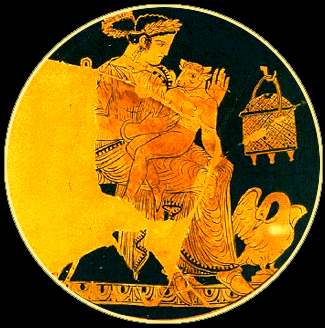Dancing Minotaur
The Minotaur; kalos inscription. Tondo of an Attic bilingual kylix, Painter of London E 4, ca. 515 BC
Painting , Kodros Painter from red-figure kylix showing deeds of Theseus; Attic, 440-430 BC
But the position of the Minotaur on the cylix in the British Museum is peculiar. His arm drags without resistance, indicating that he has given up the fight, but his body is still so vigorous that his left shoulder is raised higher than the horn by which Theseus has taken hold. The explanation of this inconsistency is to be found in the difficulty presented by the circular field. Had the painter let the body of the Minotaur drag naturally there would not be sufficient room for the hero on the ground line. The great theme is Theseus, and Theseus is given space at the expense of the Minotaur George W. Elderkin
Theseus and the Minotaur, Castellani Painter
Minotaur at Athens Archeological Museum,
British Museum, E37, Epiktetos
Theseus and the Minotaur, Amphora

Pasiphae with the Minotaurus baby. A political interpretation has that the Greeks freed themselves from the tributes and the power of Crete.
Theseus and the Minotaurus Louvre G67
Theseus Slaying the Minotaur, Antoine-Louis Barye, 1841-46 , bronze, 47 cm Musée du Louvre, Paris [Source]
Tribute to the Minotaur, A. Gendron
Theseus and Minotaur, MGEt Inv 20260
Minotaur in a Labyrinth, c. 1800 (a centaur version)
Theseus (with foustanella) and the Minotaur, a 1961 work of the Greek artist Nikos Engonopoulos
The Minotaur story from 2 Paintings
Retrieved from "http://en.wikipedia.org"
All text is available under the terms of the GNU Free Documentation License

 Disclaimer
Disclaimer  Privacy Policy
Privacy Policy